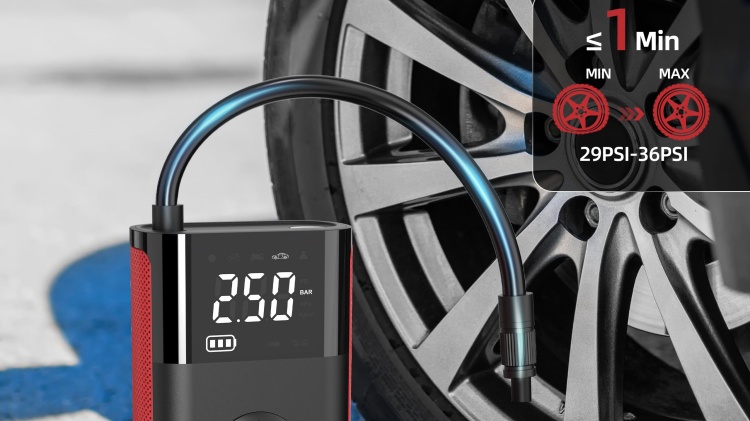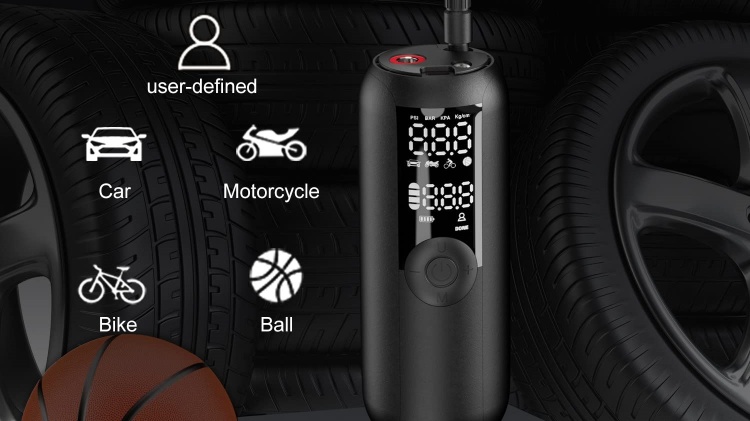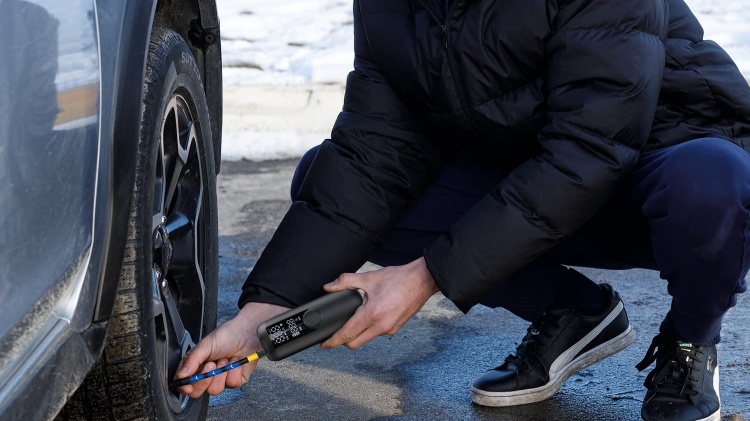Having properly inflated tires is essential for safe driving and increased fuel economy. An electric air pump allows you to easily inflate and maintain your car’s tire pressure from home.
This comprehensive guide will provide step-by-step instructions for using an electric air pump to inflate your car tires.

The importance of proper tire inflation
Maintaining the correct tire pressure is critical for several reasons:
Improved gas mileage
Underinflated tires create more rolling resistance with the road surface, which reduces fuel economy. This forces the engine to work harder to move the vehicle. Studies show that properly inflated tires can improve gas mileage by up to 3%. Over the life of your car, this can lead to significant fuel savings.
Enhanced handling and braking
The right tire pressure allows the tread to fully contact the road, providing better traction and grip. Properly inflated tires allow for improved steering, braking and handling. You’ll notice a huge difference in control compared to low tires.
Extended tire life
Underinflated tires wear unevenly and deteriorate faster. The tread wears incorrectly, causing bald spots and rapid erosion. Keeping your tires inflated to the recommended PSI extends the usable life of your tires by thousands of miles. This saves you money by reducing premature replacement costs.
Prevent blowouts
Underinflated tires are more susceptible to dangerous blowouts, especially at high speeds. They are less stable and at higher risk of failure. Correct tire pressure provides structural stability and prevents sudden blowouts that can be hazardous.
Improved safety
The right pressure allows your tires to perform better in stopping, cornering, traction and steering response. This greatly enhances driving safety by giving you more control behind the wheel during emergency maneuvers.
Save money
In addition to fuel savings and lower replacement costs, maintaining proper inflation protects the life of your wheels. Low pressures cause extra wear on tires and wheels. Overall, inflating your tires properly can save hundreds of dollars over the vehicle’s lifetime.
When to check and inflate your tires
To maintain optimal inflation, you should check your tire pressures frequently:
- Monthly – Check all tires, including the spare at least once a month when the tires are cold. This provides the most accurate pressure reading.
- Before long trips – Always inspect your tire pressure before embarking on a long drive of 250+ miles. Having properly inflated tires prevents excessive wear over long distances.
- With the seasons – Tire pressure fluctuates with changes in weather from summer heat to winter cold. Recheck them when moving into a new season.
- After drastic temperature changes – Significant temperature swings from very hot or cold days can cause psi changes. Recheck pressure after temps fluctuate more than 20°F.
- If handling seems off – Pay attention to how your vehicle handles it. If you notice any change in braking distances, cornering grip or vibrations, have your tires inspected.
- After hitting potholes – Striking potholes can dent wheels, cause leaks and affect tire pressure. Be sure to check pressures after encountering potholes.
- Before towing – Towing a trailer places more load on tires which impacts pressure. Inflate tires to recommended pressures for towing before loading up.
- Once a week – Check all tire pressures at least weekly if possible. This helps you stay on top of any gradual pressure loss.
Finding the correct tire pressure
The proper inflation pressure for your specific tires will be listed in several places:
- Vehicle owner’s manual – Consult the owner’s manual for your vehicle’s make, model and year. There should be a listing for recommended front and rear tire pressures.
- Inside the driver’s door jamb – Look inside the driver’s door. There is often a sticker with important vehicle data including the proper psi for your tires.
- Inside the fuel door – Many fuel doors have a sticker detailing recommended tire pressures. It’s easily accessed when filling up with gas.
- On the tire sidewall – Look at the tires themselves. The maximum pressure for the tire will be molded into the sidewall. This is the highest psi the tire can hold, not necessarily the optimal pressure.
- Tire manufacturer website – Search for your specific tire brand and model. The manufacturer will provide pressure recommendations.
- Vehicle manufacturer website – You can find tire pressure info for your specific car make and model on the manufacturer’s website.
How to use an electric air pump
Electric air pumps provide a convenient way to inflate your tires from home. Follow these step-by-step instructions:
- Position the Pump Next to the Tire: Place the air pump on the ground as close to the tire’s valve stem as the hose allows. Make sure the pump can reach the stem without any strain on the hose.
- Remove Tire Valve Stem Cap: Unscrew and remove the plastic or metal cap that covers the valve stem on the tire you are inflating. This gives you access to inflate the tire.
- Attach Pump Fitting to Valve Stem: Securely press the pump’s connector nozzle onto the tire’s valve stem. The mechanism will lock the pump’s fitting tightly onto the stem. Verify it is pressed on firmly.
- Plug-in Pump & Flip Switch: Plug the electric pump’s power cord into an outdoor extension cord or wall outlet. Make sure the outlet is GFCI-protected in case of electric shorts. Turn the pump’s power switch to the on position.
- Set Target Pressure on Gauge: Use the pump’s pressure gauge and arrow buttons to set the desired PSI you want to inflate the tire to. Refer to your owner’s manual or door jamb sticker for the recommended figure.
- Begin Inflation: With the hose tightly connected and the target pressure set, press the inflation button or toggle switch to start the pump. This will begin pumping air into the tire.
- Monitor Pressure Readings: Keep an eye on the pressure gauge display as the pump inflates the tire. The gauge will climb until it approaches the preset target number. The final psi may slightly overshoot.
- Turn Off Pump at Correct Pressure: When the gauge indicates your target inflation pressure has been reached, turn off the air pump. It’s normal for it to go 1-2 psi above the setting.
- Detach and Repeat: Disconnect the pump connector fitting from the valve stem. Repeat steps 2-8 for any other tires that need inflating to the proper pressures.
- Reattach Stem Caps: When finished inflating all tires, reattach the valve stem caps by screwing them back on tightly. This protects the valves from dirt, moisture and damage.

Helpful features to look for
Today’s electric air pumps offer many convenient features:
- Automatic shut off – Shut the pump off automatically when target pressure is reached to prevent overinflation.
- Built-in pressure gauge – Displays tire pressure via digital readout for precise inflation. Eliminates the need for a separate gauge.
- Portable and lightweight – Compact compressors that can be easily stored in your vehicle and plugged into the 12V outlet.
- Dual quick-connect chucks – Provide both cone and needle valve fittings to work with all tire valve stem types.
- Preset pressure settings – This allows you to preset common pressures like 30, 35, and 40 psi for faster inflation.
- LED work light – Illuminates the valve area for visibility when inflating at dusk or at night.
- 12-volt and wall plug-ins – Can be powered from a wall outlet or car’s 12V power outlet for flexibility. Look for at least a 15-amp fuse.
- Analog pressure gauges – Older designs may have a physical needle gauge instead of a digital one. These work fine but digital offers more precision.
- Long power cord – A cord 6 feet or longer provides flexibility in reaching wheels and power sources.
Tips for proper tire inflation
Adhere to these tips and best practices when using your electric pump:
- Only inflate when tires are cold – Add air before driving or let cool for 3+ hours. Driving heats tires and yields inaccurate readings.
- Inflate to recommended PSI – Use your vehicle’s specifications, not what is molded on the tire sidewall.
- Remove the hose before turning off – Always detach the hose from the stem before powering off the pump to avoid pressure loss.
- Check pressure and gauge accuracy – The pump gauge may not read 100% accurately on its own. Confirm readings with a tire pressure gauge after inflation.
- Store pump properly – Keep the electric pump in a clean, moisture-free space away from extreme temperatures. Improper storage can damage pumps.
- Maintain pump filter – Periodically check and clean the pump air filter so it operates efficiently without blockages or reduced airflow.
- Watch for leaks – If a tire rapidly loses air, have it inspected for punctures. Slow leaks will cause you to lose pressure.
- Only inflate, don’t overfill – Only inflate to recommended PSI, not the max pressure molded on the tire sidewall to avoid a blowout.
- Avoid overheating – Don’t run the pump continuously for more than 10 minutes. Let cool for 30 minutes between long inflations.
Troubleshooting common electric pump problems
While reliable overall, issues can occasionally arise with electric tire pumps:
Pump won’t turn on
- Check that the pump is plugged into a working grounded outlet with proper voltage.
- Try resetting tripped circuit breakers or GFCI outlets.
- Use a heavy-duty extension cord if the outlet is hard to reach.
- Test the outlet with a lamp to verify power is being supplied.
Pump runs but won’t inflate
- Confirm fitting is pressed tightly onto the valve stem with no air leaks.
- Inspect the hose for holes, blockages or kinks that prevent airflow.
- Clean the pump air filter which may be clogged with dirt or debris.
- Review the owner’s manual for priming and air bleeding instructions to remove trapped air.
Pump stops or resets while inflating
- Avoid overheating by not running the pump continuously for more than 10 minutes.
- Let the pump cool down for 30 minutes if it overheats and then restart.
- Make sure the power cord is not tightly coiled to avoid overheating.
- Confirm outlet provides 110-120V power and is not a 220-volt outlet.
Gauge shows different pressure than standard gauge
- Always rely on a known recently calibrated tire pressure gauge for true accurate pressure.
- The pump gauge may be slightly inaccurate if damaged or not properly calibrated.
- Watch online tutorial videos to test gauge calibration and recalibrate if needed.
Pump gauge shows 0 PSI at startup
- Gently tap or turn the pump to jostle any stuck internal gauge movements.
- Check if the pressure gauge is damaged or leaking airflow. Order replacement if defective.
Pump runs noisily or vibrates
- Listen to motor issues and contact manufacturers if under warranty.
- Tighten case screws and inspect gaskets/seals to eliminate housing vibrations or air leaks.

Safety tips for proper tire inflation
While very useful, it’s important to keep safety in mind when using an electric air pump:
- Wear eye protection – Bits of debris and dirt can shoot out when initially inflating. Use protective glasses or goggles.
- Point nozzle away – Do not point the pump nozzle toward your face or body when starting inflation. Redirect if needed.
- No overinflation – Only inflate to the recommended PSI, not the higher max pressure printed on tire sidewall. Overinflation can cause tires to explode.
- Check for damage – Carefully inspect tires for cuts, bulges, bald spots or sidewall damage before inflating. Damaged tires can rupture.
- Monitor during use – Stay near the pump during inflation to check pressure frequently. Do not set and walk away.
- Use a pressure gauge – Depend on an accurate tire pressure gauge, not just the pump’s gauge, to verify the correct PSI.
- Stay clear of the pump – Avoid touching the pump during use as the motor and sealed chambers get hot while running. Keep children and pets at a safe distance.
- Mind the moving parts – Keep hands, hair, and clothing away from fan blades, belts, couplings and any moving parts when the pump is powered on.
- Beware of carbon monoxide – Only operate electric pumps in well-ventilated outdoor areas. They produce toxic exhaust. Never run inside an enclosed space.
- Secure it while transporting – When storing a portable pump in your vehicle, secure it so it doesn’t fly loose and cause injury in an accident.
Maintaining your electric air pump
Do regular maintenance to ensure your tire pump operates smoothly for years:
- Wipe exterior clean after use and store properly indoors. Moisture and dirt can damage pumps.
- Check compression fittings and hose for signs of wear. Replace loose, cracked or damaged parts.
- Change pump oil if your model requires lubrication per manufacturer instructions.
- Inspect power cords for cracks or exposed wires. The exchange cord is damaged or frayed.
- Remove the air filter and clean built-up debris with compressed air or mild soap and water.
- Test the pump yearly by inflating a tire to proper PSI. Confirm pressure gauge is still accurate.
- If the pump struggles or runs slowly, is it serviced? Worn internal parts reduce performance.
- Order replacement parts from the manufacturer. Repairing yourself can void warranties.
Proper tire inflation is a vital part of car maintenance for performance, fuel economy and safety. Equipping yourself with an electric air pump makes checking and filling tires fast and convenient.
Follow this comprehensive guide and you’ll be able to quickly inflate your tires properly. Keeping tires inflated to the correct pressure extends their life, saves fuel and most importantly – protects you on the road.
Now you have the helpful step-by-step instructions you need to use an electric pump safely and efficiently. Maintain those tires and enjoy many miles of comfortable, confident driving!













